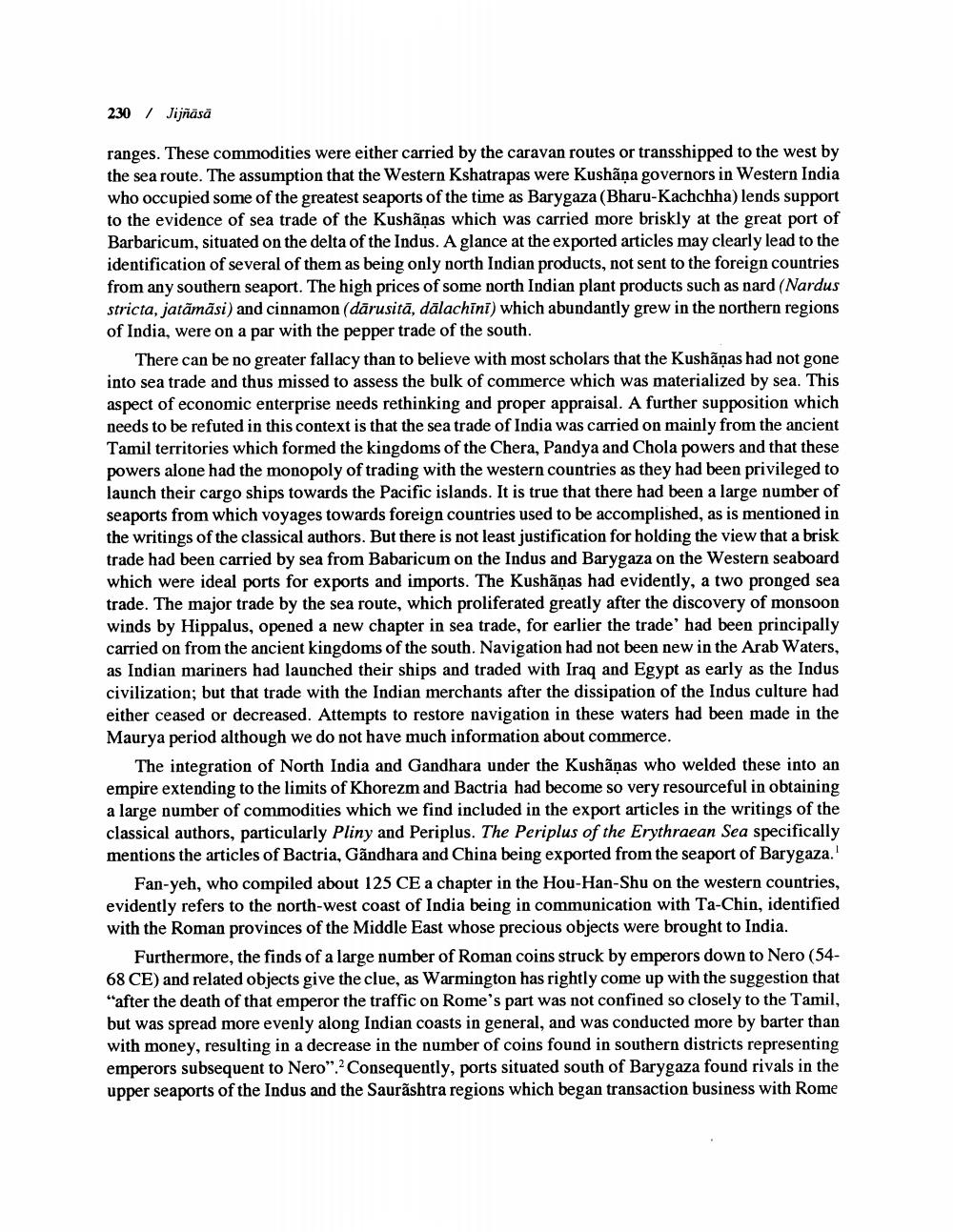________________
230 / Jijñāsā
ranges. These commodities were either carried by the caravan routes or transshipped to the west by the sea route. The assumption that the Western Kshatrapas were Kushaṇa governors in Western India who occupied some of the greatest seaports of the time as Barygaza (Bharu-Kachchha) lends support to the evidence of sea trade of the Kushaṇas which was carried more briskly at the great port of Barbaricum, situated on the delta of the Indus. A glance at the exported articles may clearly lead to the identification of several of them as being only north Indian products, not sent to the foreign countries from any southern seaport. The high prices of some north Indian plant products such as nard (Nardus stricta, jatāmāsi) and cinnamon (dārusitā, dālachīnī) which abundantly grew in the northern regions of India, were on a par with the pepper trade of the south.
There can be no greater fallacy than to believe with most scholars that the Kushaṇas had not gone into sea trade and thus missed to assess the bulk of commerce which was materialized by sea. This aspect of economic enterprise needs rethinking and proper appraisal. A further supposition which needs to be refuted in this context is that the sea trade of India was carried on mainly from the ancient Tamil territories which formed the kingdoms of the Chera, Pandya and Chola powers and that these powers alone had the monopoly of trading with the western countries as they had been privileged to launch their cargo ships towards the Pacific islands. It is true that there had been a large number of seaports from which voyages towards foreign countries used to be accomplished, as is mentioned in the writings of the classical authors. But there is not least justification for holding the view that a brisk trade had been carried by sea from Babaricum on the Indus and Barygaza on the Western seaboard which were ideal ports for exports and imports. The Kushaņas had evidently, a two pronged sea trade. The major trade by the sea route, which proliferated greatly after the discovery of monsoon winds by Hippalus, opened a new chapter in sea trade, for earlier the trade" had been principally carried on from the ancient kingdoms of the south. Navigation had not been new in the Arab Waters, as Indian mariners had launched their ships and traded with Iraq and Egypt as early as the Indus civilization; but that trade with the Indian merchants after the dissipation of the Indus culture had either ceased or decreased. Attempts to restore navigation in these waters had been made in the Maurya period although we do not have much information about commerce.
The integration of North India and Gandhara under the Kushaṇas who welded these into an empire extending to the limits of Khorezm and Bactria had become so very resourceful in obtaining a large number of commodities which we find included in the export articles in the writings of the classical authors, particularly Pliny and Periplus. The Periplus of the Erythraean Sea specifically mentions the articles of Bactria, Gandhara and China being exported from the seaport of Barygaza.'
Fan-yeh, who compiled about 125 CE a chapter in the Hou-Han-Shu on the western countries, evidently refers to the north-west coast of India being in communication with Ta-Chin, identified with the Roman provinces of the Middle East whose precious objects were brought to India.
Furthermore, the finds of a large number of Roman coins struck by emperors down to Nero (5468 CE) and related objects give the clue, as Warmington has rightly come up with the suggestion that "after the death of that emperor the traffic on Rome's part was not confined so closely to the Tamil, but was spread more evenly along Indian coasts in general, and was conducted more by barter than with money, resulting in a decrease in the number of coins found in southern districts representing emperors subsequent to Nero". Consequently, ports situated south of Barygaza found rivals in the upper seaports of the Indus and the Saurashtra regions which began transaction business with Rome




